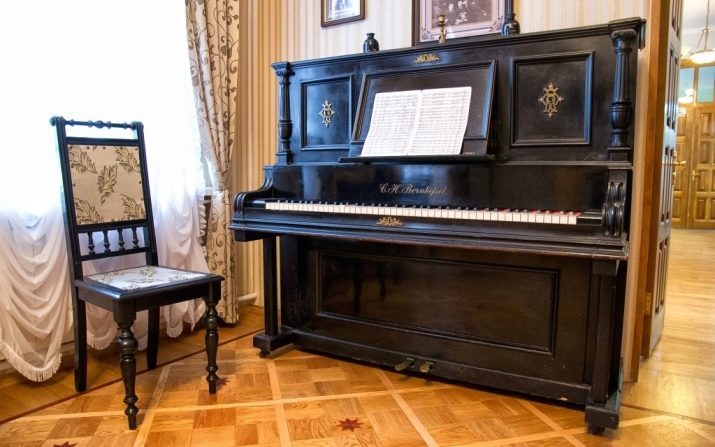All about transporting a piano

Moving a piano is a multi-step process, from packaging the instrument to loading and unloading. Since it happens quite rarely, there are many questions about how to organize the work. To figure out how to properly transport a piano and a grand piano, whether it is possible to disassemble the instrument for transportation on your own, a step-by-step consideration of all the important points will help.
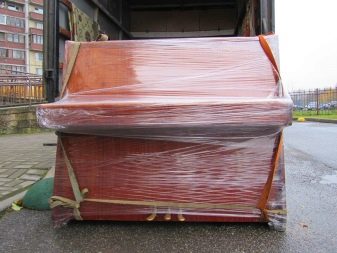
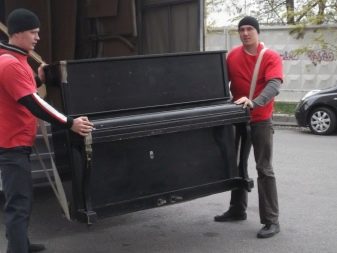
Do I need to disassemble the instrument?
Pianos, grand pianos, pianos are musical instruments that require extremely delicate handling even during operation. What can we say about transportation, during which you have to move them a considerable distance, lower them down the flights of stairs, and carry them out through doorways. At the same time, at first glance, it is not possible to disassemble the body or its contents. A more thorough study of the tool design helps to make the final decision in this matter.
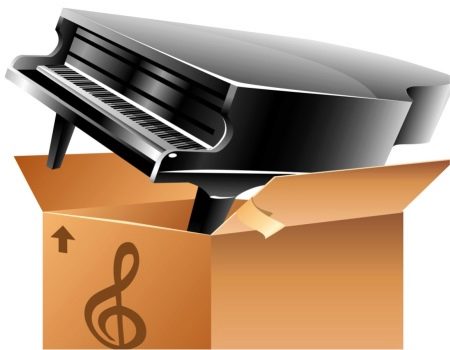
In the absence of relevant experience, it is not recommended to transport the piano yourself. It is highly likely that the instrument will lose its sound, tuning, or receive mechanical damage. In addition, its average weight varies in the range from 140 to 400 kg, and even more for models released in the 18th-19th centuries that have the status of antiques. Accordingly, even two people will find it difficult to cope with the task without additional help.
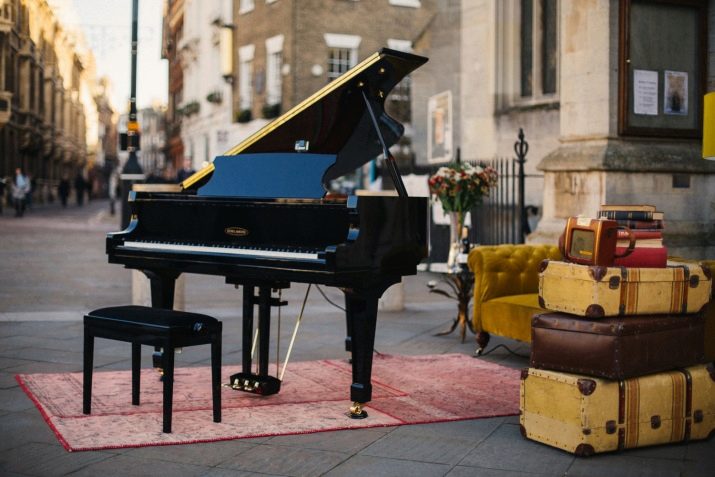
The piano, according to cargo standards, belongs to large-sized objects. Its transportation implies a change in the original position of the case, it can damage sensitive mechanisms.At the same time, it is not at all necessary to disassemble the tool, dismantle the elements of its body. Usually, during transportation, the shipment takes place in its entirety, but in some cases it will be wiser to still reduce the weight.
In this case, you can dismantle the following items.
- Panel above the keyboard... It is unscrewed with a screwdriver and is held in place by screws.
- Cover hiding the pedal mechanism... It is fixed with a special latch. It is possible to dismantle this structural element without the use of additional tools, as well as to install it after transportation. Depending on the model, the cover can be split: from the top and bottom panels. In this case, each element is removed separately.
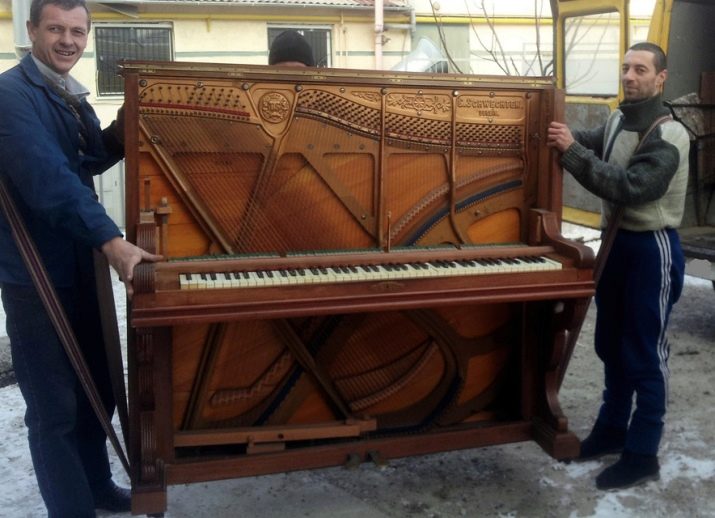
It is not recommended to dismantle the elements of the percussion mechanism. It is removed only when urgently needed, by loosening and then removing the mounting bolts. After that, you can start packing the structure for subsequent transportation.
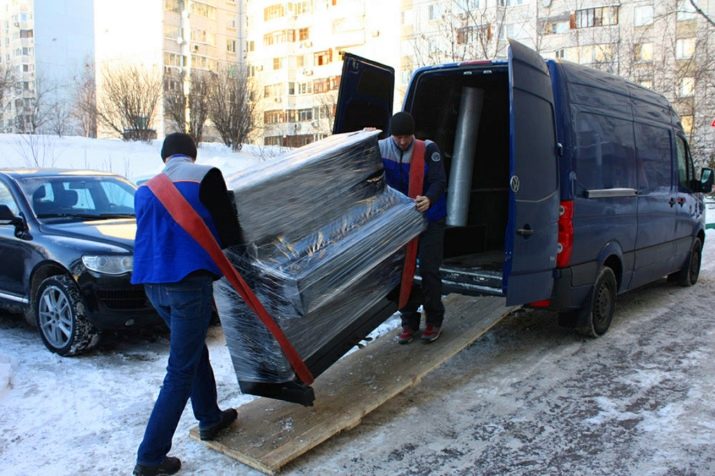
General transport rules
Transportation of pianos, pianos, grand pianos is made according to standard rules, using the necessary rigging equipment and fixtures... You can place a properly packed instrument lying or standing, but it is not recommended to turn it over on your own - there is a great risk of overturning. During transportation, musical instruments must be secured with special belts and other fasteners in order to avoid their displacement in the body of the vehicle.
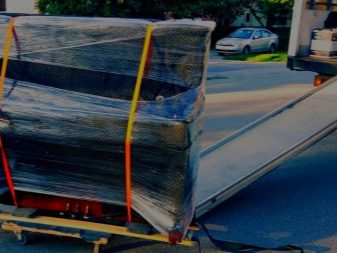
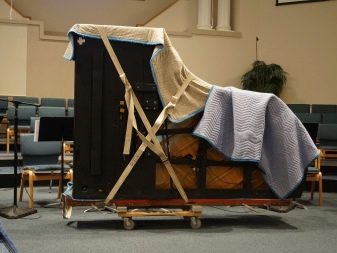
You can successfully transport a piano or grand piano in a van or pickup car, if the dimensions allow. It is important to follow the instructions, to avoid intense mechanical, shock, vibration loads. It is better to move and load large-sized tools with the help of specialized rigging equipment and mechanized equipment.
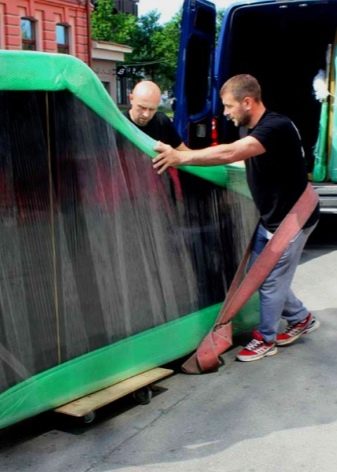
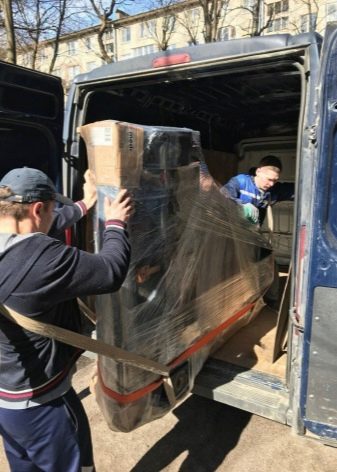
Package
Before transporting the piano, be sure to pack it properly. Moreover, you will have to protect not only the outer lacquered elements of the case, but also other parts that are of great structural importance. Prevent damage to valuable property by performing the following work in advance.
- Laying strings with thick sheets of cardboard. This will save them from possible damage.
- Key protection. Here you should stock up on foam rubber or felt, batting, cutting it to size. After that, the keys must be laid with the selected soft layer, covered with a lid. It is better to fix it with adhesive tape.
- Protection of protruding elements. Here we are talking about the protection of the polished or lacquered decorative layer. The easiest way is to take packing cardboard and secure it with adhesive tape.
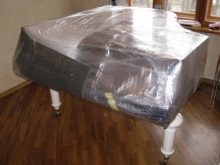
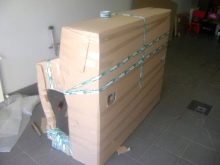
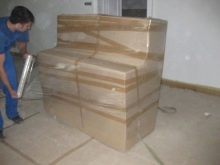
During transportation assembled, without additional dismantling of elements, all opening parts of the musical instrument are temporarily fixed to avoid injury. The product itself, prepared for transportation, is recommended to be carefully wrapped in bubble polyethylene immediately before loading.
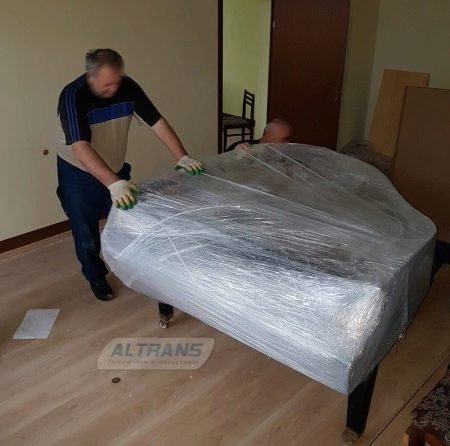
In the absence of specialized packaging materials at hand, you can use the tools at hand: blankets, blankets.
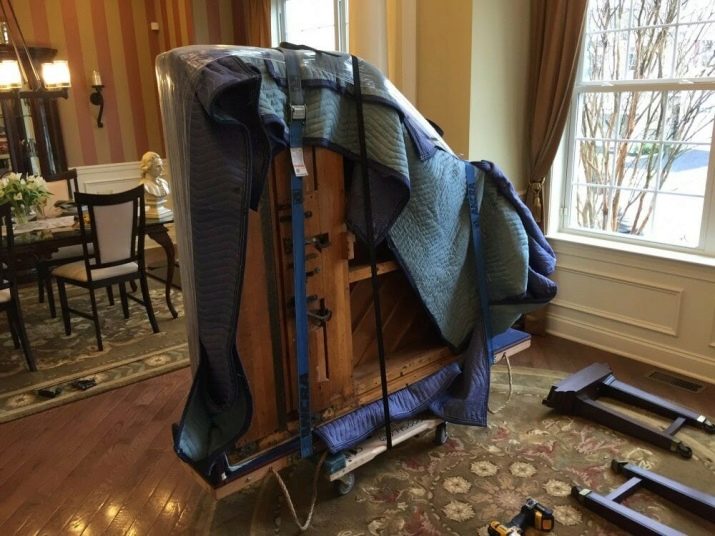
Loading and unloading
The process of directly moving a musical instrument also has its own characteristics. Bulky goods are handled manually only if they successfully pass through the doorway. The work begins by measuring the length and width of the piano itself. Then, similar manipulations are performed with doors, staircases. It is necessary to take into account not only the rectilinear trajectories of movement, but also the possible turns of the flights of stairs.
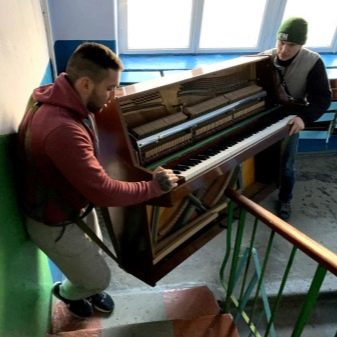
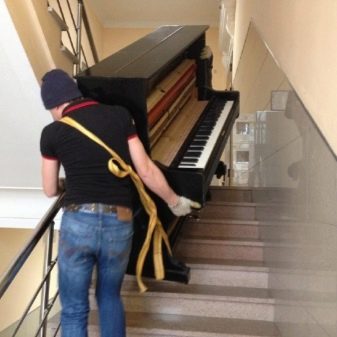
If the opening turns out to be not wide enough, it is increased by removing the doors from the hinges, disassembling the jambs. Especially large musical instruments such as grand pianos are moved with cranes and lifting hinges through window openings.
Also, in the process of preparing for loading and unloading operations, it is worth taking care of the following points.
- Clearing the route. In living quarters, furniture, things, other objects should be removed, and pets should be removed.
- Warning neighbors. This moment is especially relevant in apartment buildings in the absence of a freight elevator.
- Preparing the ladder. You will need it to load the musical instrument into the back of the vehicle selected for transportation.
- Finding the right trolley... It will come in handy when moving the piano on the street or indoors in the absence of elevation differences.
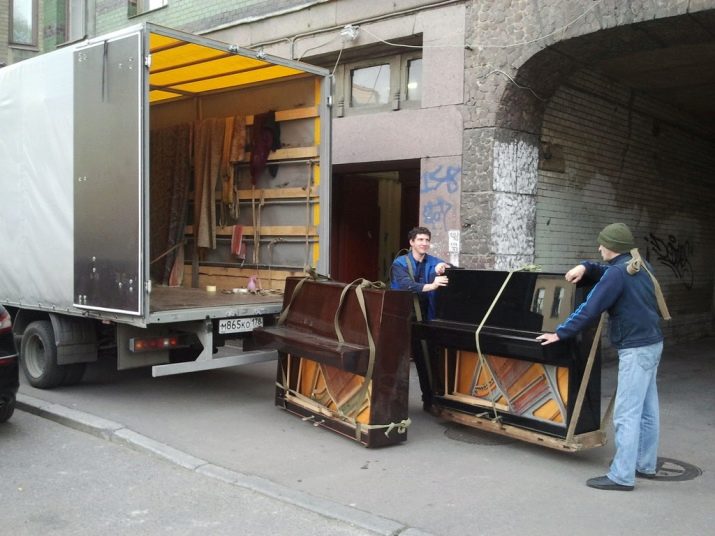
When loading and unloading yourself, it is worth preparing for the work from the very beginning. For every 40-45 kg of instrument weight, you will need at least 1 physically developed person to carry it. It is better to provide for the possibility of substitution or safety net. It is better to carry the piano with rubber or PVC-coated gloves. If possible, you should rent or purchase lifting devices - belts that facilitate transportation.
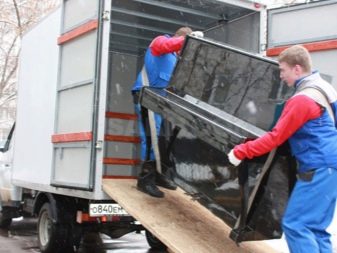
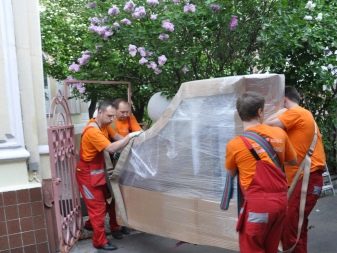
In the process of carrying, it is worth taking care of the synchronization of actions. Raise the piano on all sides at the same time, periodically make stops to rest... It can only be lowered onto a hard, level surface, after making sure that the instrument does not lose balance.
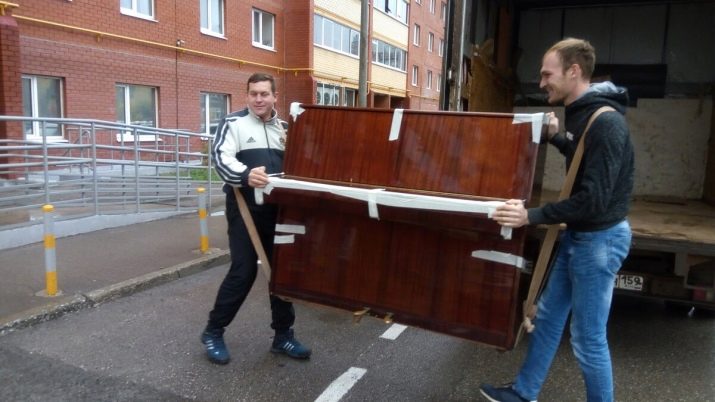
It is not necessary to unpack the piano after delivery, especially when there is a significant difference in temperatures outside and indoors, not immediately, but after 1-2 hours.
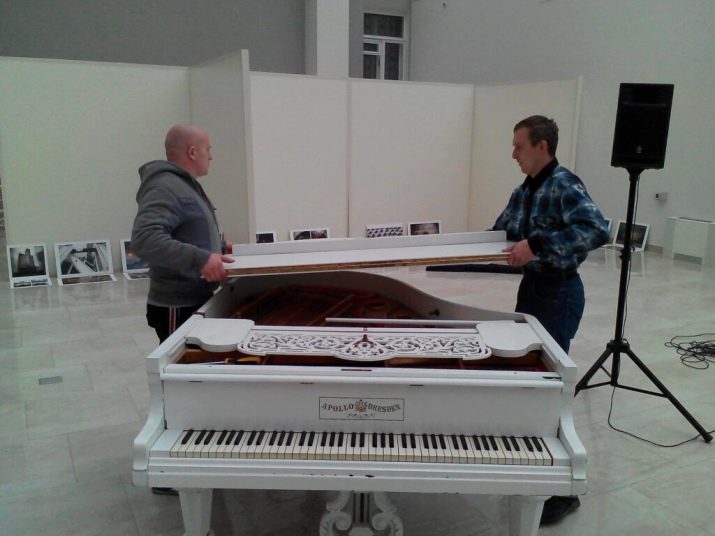
Important nuances
There are many subtleties that are well known to professionals in the field of moving, but completely incomprehensible to people far from this field. When planning to transport a piano over a long distance, you need to make sure that the technical condition of the musical instrument allows you to do this.
When carrying out transportation, a number of nuances should be taken into account.
- Transportation method. The simplest option - the stairs - involves exclusively the use of manual labor. If the house has an elevator for cargo transportation, it is better to use a trolley, with the help of which even bulky cargo can be successfully moved down the floors.
- Moving range... All auxiliary structural elements of the musical instrument - rollers, handles on the back wall - are intended only for shifting the piano within a few centimeters. Do not rely on them for more distant transportation. The rollers, in addition to the general unreliability, also leave deep indentation marks on the surface of the flooring.
- Staircase method... It is strictly forbidden to place the tool at an angle on the surface of the steps. This can damage the bottom of the case.
- Route selection. When moving particularly fragile, shaking-sensitive objects, it is imperative to choose roads with high-quality surfaces. Any vibration or shock can damage the piano or piano.
- Tool position. It is fixed in the vehicle body with belts and other devices. It is safest to transport in a horizontal position if the machine is not equipped with rigging elements.
- Time period selection. You should not plan to transport large-sized musical instruments during periods of high air humidity, as well as when atmospheric temperatures drop below 0 ° C. In the absence of other options, transport can be carried out, but the instrument itself can be unpacked on site with a delay.
- Deterioration in sound quality. It is highly likely that the piano will lose its previous tuning after transport. But don't be in a hurry. It is recommended to postpone the call of the tuner for a period of at least a week.
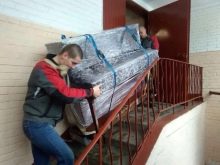
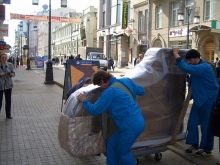
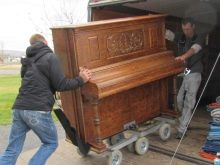
Considering all these points, it will be possible to cope with the transportation of the piano when moving, even without the help of special services dealing with cargo transportation.
